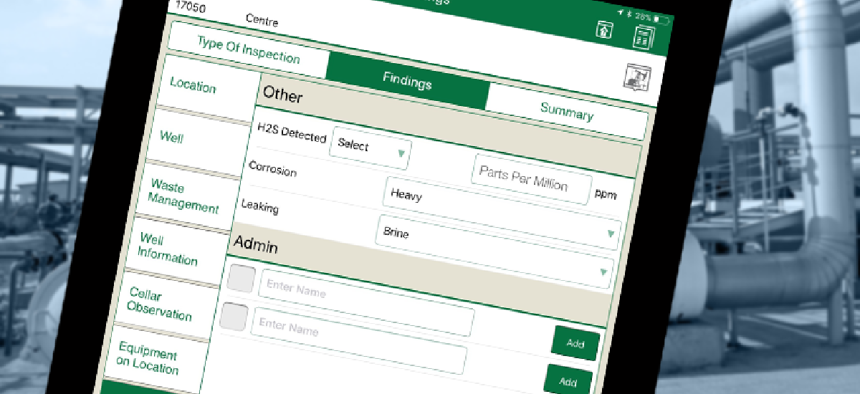Environmental inspectors find mobile app to be a force multiplier

With the help of tablet-based app, Pennsylvania's Department of Environmental Protection "massively" increased the number and accuracy of its inspections of oil and gas wells.
After years of conducting paper-based inspections of oil and gas drilling sites, inspectors at the Pennsylvania Department of Environmental Protection have gone digital.
Using department-issued Apple iPads preloaded with DEP’s eInspection app, inspectors completed about 2,000 more inspections in 2017 than they did in 2016 -- an increase of about 11.5 percent -- and increased their productivity by 29 percent in the fourth quarter of 2017. Launched in February 2017, the app has saved DEP more than $500,000, or the equivalent of six additional inspectors.
“We recognized a gross inefficiency in our inspection process," said Scott Perry, deputy secretary of DEP’s Office of Oil and Gas Management. "Our inspectors would have to take their paper inspection reports and come back into the office and transcribe them into our data management system.”
By simply eliminating that step, the department could "massively" increase the number of inspections it conducts without having to add additional staff, he added.
The eInpsection app also made inspection reports more accurate because users enter far less data manually. The app comes loaded with drop-down menus of information commonly recorded at inspections. For example, it has choices for the site location and operator, and the drop-down menus let users select the equipment they inspected. There are also preloaded regulatory citations and explanations for any violations. Lastly, inspectors can upload photos they take on-site and add remarks in an open comment box.
“We didn’t just take our old paper form and turn it into the online inspection form,” Perry said. “We completely modernized the process to make it even more of a useful tool for the inspectors.”
Additionally, well operators can see the results of the inspection in real time. Once an inspector submits the report, it becomes a public record and is immediately available on DEP’s GIS website, which shows the location, type and status for each well, including inspection information.
The app's other features include photo- and voice-recognition capabilities and a connection to EFACTS, the DEP inspection and compliance management database. That integration lets inspectors access all the department’s data while onsite so that they can review, for instance, previous inspection results.
When inspectors are working in areas without internet connectivity, they can pull the information from the app and save it to the tablet to upload when they’re able to connect again.
“In the past, the paper inspection form was the official record of the agency, and the information that was transcribed in the data management system would be a summary, so it wouldn’t necessarily have all of the information that was available in the paper file,” Perry said. “Now, all of that information is made available immediately not just to the company, but to the public as well.”
The software that eInpection uses was custom built by the state’s Transportation Department and adapted over a year by the DEP IT team for inspectors’ use.
“They actually had this tool first, and we were able to partner with their development team to more rapidly implement it for us,” Perry said.
That partnership aligns with the Governor’s Office of Transformation, Innovation, Management and Efficiency initiative, which aims to modernize government operations and thereby reduce costs and improve services. One way GO-TIME encourages efficiency is through shared resources and collaboration.
Feedback on the app has been positive, Perry said. “When you change folks’ process, they typically are not very happy about that, and I’ve just been so pleased with the overwhelming acceptance of it,” he added.
On his wish list are enhancements that take advantage of the app’s built-in GPS capabilities. It would use latitude and longitude to automatically enter inspectors’ locations. Perry said he also plans to use the tool to better track where and how often inspections are occurring.





